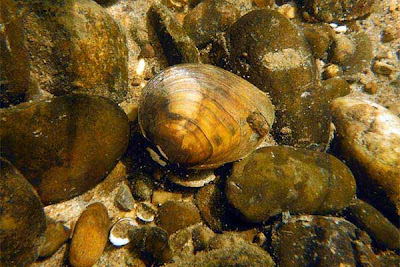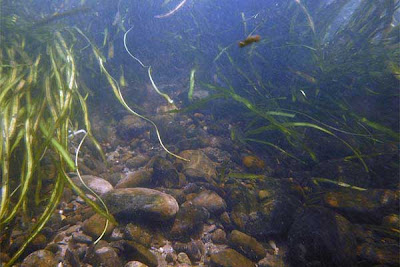Pennsylvania is known for a lot of things—spectacular trout fishing, abundant energy resources, intensely rivaled hockey teams—but one of the lesser known treasures of Pennsylvania is its native freshwater mussels.
Species almost lost elsewhere are known from the Allegheny River and French Creek in western Pennsylvania, and they are the envy of several neighboring states where the mussels have either been lost or populations are too small to survive without assistance. For example, although it remains in only five percent of its historical range, the northern riffleshell continues to have thriving populations in Pennsylvania. Likewise, the clubshell mussel also has stronghold populations in the Commonwealth.
 |
| Clubshell mussel. Credit: USFWS |
On a related, and potentially challenging note, a lot of Pennsylvania’s highway infrastructure is aging and in need of upgrade or replacement. So what happens when a bridge spanning a massive mussel bed with hundreds of thousands of endangered individuals needs to be replaced? This question had the Fish and Wildlife Service and partner agencies scratching their heads. The solution, as it turns out, may help move clubshell and northern riffleshell towards recovery.
After working with project planners and engineers to minimize potential adverse effects, the Service and the Pennsylvania Department of Transportation determined that it was not feasible to replace the Hunter Station Bridge in Forest County, Pennsylvania, and simultaneously avoid all impacts to listed species in the project area. We started brainstorming ways to mitigate, or make up, for those impacts.
 |
A clean river, the Allegheny bottom is rocky with stands of eelgrass.
Credit: Kristen Lundh/USFWS |
As part of the Fish and Wildlife Service’s formal recovery plan for northern riffleshell and clubshell, biologists have worked to reestablish healthy populations of both species within the historical ranges of the species. Doing so required addressing historical water quality issues in the Vermilion and Salt Fork River in Illinois; Big Darby Creek, Ohio; and Elk Creek, West Virginia, that are responsible for the decline or extirpation of northern riffleshell from their waters.
In addition, successful pilot studies in previous years with relocated mussels indicate that the cleanup efforts have been successful. As such, the Service found these locations ideal for transplanting some of Allegheny’s endangered mussels that may otherwise be lost due to the bridge replacement.
On August 23 this year, staff from the Columbus Zoo Freshwater Mussel Conservation and Research Center, Illinois Department of Natural Resources, Illinois Natural History Survey, Ohio State University, Pennsylvania Boat and Fish Commission and the West Virginia Division of Natural Resources assisted with collecting and relocating mussels from the Hunter Station bridge.
 |
| Divers sort mussels collected in the Allegheny River under the Hunter Station bridge. Credit: Jim Carroll/PennDOT |
All told, the collection and relocation effort moved more than a thousand mussels from Hunter Station to their new homes in Illinois, Ohio and West Virginia, Ohio. Although future monitoring is needed to determine the long term success of the translocation, reestablishing northern riffleshell in these states would go a long way towards accomplishing recovery goals for the species as a whole.
Translocation is not the solution for every endangered species conflict, but this project demonstrates that in some situations, it can be a successful tool for conservation and recovery.
And who knows, once the word gets out that that western Pennsylvania hosts such a unique resource, folks in Pittsburgh will demand that the Penguins be renamed something more locally-appropriate (not to mention intimidating), like … the Clubshells … and then again, maybe they won’t.
More:
- Information and photos from the Service's Midwest Region website
- News release from Pennsylvania Fish and Boat Commission
No comments:
Post a Comment